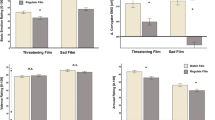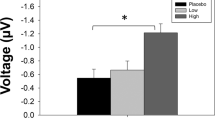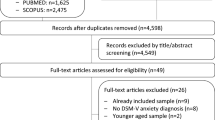Abstract
Increased neural error monitoring, as measured by the error-related negativity (ERN), is a transdiagnostic neurobiological marker of anxiety. To date, little is known about whether the ERN can inform the choice between first-line anxiety disorder treatments and whether the ERN changes following treatment completion. The aim of the study was to therefore assess whether the ERN is a treatment moderator and index of symptom change during cognitive-behavioral therapy (CBT) or selective serotonin reuptake inhibitors (SSRIs). Participants included adult volunteers (M age=25.8±8.5; 67% female) with principal anxiety disorders (n=60) or no lifetime history of Axis I psychopathology (ie, healthy controls; n=26). A flanker task was used to elicit the ERN at baseline and 12 weeks later, following either CBT or SSRIs in the patient sample. Results indicated that baseline ERN was a significant treatment moderator such that a more enhanced baseline ERN was associated with greater reduction in anxiety symptoms within individuals who received CBT but not SSRIs. Results also revealed that the ERN increased pre- to post-treatment among patients randomized to SSRIs, but remained stable among patients randomized to CBT and healthy controls. Together, these novel findings highlight that ERN may help guide treatment decisions regarding engagement in CBT or SSRIs, especially among individuals with an enhanced ERN. The findings also suggest that SSRIs have the capacity to alter individual differences in the ERN, providing evidence that the ERN is not entirely static in patients with anxiety disorders.
Similar content being viewed by others
Log in or create a free account to read this content
Gain free access to this article, as well as selected content from this journal and more on nature.com
or
References
Ainsworth K, Smith SE, Zetterstrom TS, Pei Q, Franklin M, Sharp T (1998). Effect of antidepressant drugs on dopamine D1 and D2 receptor expression and dopamine release in the nucleus accumbens of the rat. Psychopharmacology (Berlin) 140: 470–477.
Anokhin AP, Golosheykin S, Heath AC (2008). Heritability of frontal brain function related to action monitoring. Psychophysiology 45: 524–534.
Arch JJ, Craske MG (2009). First-line treatment: a critical appraisal of cognitive behavioral therapy developments and alternatives. Psychiatr Clin North Am 32: 525–547.
Baldwin DS, Anderson IM, Nutt DJ, Allgulander C, Bandelow B, den Boer JA et al (2014). Evidence-based pharmacological treatment of anxiety disorders, post-traumatic stress disorder and obsessive-compulsive disorder: a revision of the 2005 guidelines from the British Association for Psychopharmacology. J Psychopharmacol 28: 403–439.
Barlow DH, Craske MG (2006) Mastery of your anxiety and panic. Oxford University Press: New York.
Boksem MA, Tops M, Wester AE, Meijman TF, Lorist MM (2006). Error-related ERP components and individual differences in punishment and reward sensitivity. Brain Res 1101: 92–101.
Botvinick MM, Cohen JD, Carter CS (2004). Conflict monitoring and anterior cingulate cortex: an update. Trends Cogn Sci 8: 539–546.
Craske MG, Barlow DH, O'Leary TA (1992) Mastery of your anxiety and worry. Graywind Publications: Albany.
Craske MG, Kircanski K, Zelikowsky M, Mystkowski J, Chowdhury N, Baker A (2008). Optimizing inhibitory learning during exposure therapy. Behav Res Ther 46: 5–27.
Endrass T, Klawohn J, Gruetzmann R, Ischebeck M, Kathmann N (2012). Response- related negativities following correct and incorrect responses: Evidence from a temporospatial principal component analysis. Psychophysiology 49: 733–743.
Endrass T, Riesel A, Kathmann N, Buhlmann U (2014). Performance monitoring in obsessive–compulsive disorder and social anxiety disorder. J Abnorm Psychol 123: 705–714.
Eriksen BA, Eriksen CW (1974). Effects of noise letters upon the identification of a target in a nonsearch task. Percept Psychophys 16: 143–149.
Falkenstein M, Hohnsbein J, Hoormann J, Blanke L (1991). Effects of crossmodal divided attention on late ERP components. II. Error processing in choice reaction tasks. Electroen Clin Neuro 78: 447–455.
Franken IH, van Strien JW, Franzek EJ, van de Wetering BJ (2007). Error-processing deficits in patients with cocaine dependence. Biol Psychol 75: 45–51.
Gehring WJ, Goss B, Coles MGH, Meyer DE, Donchin E (1993). A neural system for error detection and compensation. Psychol Sci 4: 385–390.
Gorka SM, Burkhouse K, Afshar K, Phan KL (2017). Error-related brain activity and internalizing disorder symptom dimensions in depression and anxiety. Depress Anxiety 34: 985–995.
Gorka SM, MacNamara A, Aase DM, Proescher E, Greenstein JE, Walters R et al (2016). Impact of alcohol use disorder comorbidity on defensive reactivity to errors in veterans with posttraumatic stress disorder. Psychol Addict Behav 30: 733–742.
Guy W (1972) ECDEU assessment manual for psychopharmacology US Department of Health, Education, and Welfare, Public Health Service, Alcohol, Drug Abuse, and Mental Health Administration, National Institute of Mental Health, Psychopharmacology Research Branch, Division of Extramural Research Programs. 76: 338.
Hajcak G, Foti D (2008). Errors are aversive: defensive motivation and the error-related negativity. Psychol Sci 19: 103–108.
Hajcak G, Franklin ME, Foa EB, Simons RF (2008). Increased error-related brain activity in pediatric obsessive-compulsive disorder before and after treatment. Am J Psychiatry 165: 116–123.
Hajcak G, McDonald N, Simons RF (2004). Error-related psychophysiology and negative affect. Brain Cognition 56: 189–197.
Hall JR, Bernat EM, Patrick CJ (2007). Externalizing psychopathology and the error- related negativity. Psychol Sci 18: 326–333.
Hamilton M (1959). The assesment of anxiety states by rating. Brit J Med Psychol 32: 50–55.
Hanna GL, Gehring WJ (2016). The NIMH Research Domain Criteria initiative and error‐related brain activity. Psychophysiology 53: 386–388.
Holroyd CB, Coles MG (2002). The neural basis of human error processing: reinforcement learning, dopamine, and the error-related negativity. Psychol Rev 109: 679–709.
Kennedy SH, Konarski JZ, Segal ZV, Lau MA, Bieling PJ, McIntyre RS et al (2007). Differences in brain glucose metabolism between responders to CBT and venlafaxine in a 16-week randomized controlled trial. Am J Psychiat 164: 778–788.
Kessler RC, Chiu WT, Demler O, Walters EE (2005). Prevalence, severity, and comorbidity of 12-month DSM-IV disorders in the National Comorbidity Survey Replication. Arch Gen Psychiat 62: 617–627.
Klimke A, Larisch R, Janz A, Vosberg H, Muller-Gartner HW, Gaebel W (1999). Dopamine D2 receptor binding before and after treatment of major depression measured by IBZM SPECT. Psychiatry Res 90: 91–101.
Kozak MJ, Cuthbert BN (2016). The NIMH research domain criteria initiative: background, issues, and pragmatics. Psychophysiology 53: 286–297.
Kujawa A, Weinberg A, Bunford N, Fitzgerald KD, Hanna GL, Monk CS et al (2016). Error- related brain activity in youth and young adults before and after treatment for generalized or social anxiety disorder. Prog Neuro-Psychoph 71: 162–168.
Larisch R, Klimke A, Vosberg H, Löffler S, Gaebel W, Müller-Gärtner HW (1997). In vivo evidence for the involvement of dopamine-D2 receptors in striatum and anterior cingulate gyrus in major depression. Neuroimage 5: 251–260.
Larson MJ, Clayson PE (2011). The relationship between cognitive performance and electrophysiological indices of performance monitoring. Cogn Affect Behav Neurosci 11: 159–171.
Lovibond SH, Lovibond PF (1995) Manual for the depression anxiety stress scale. 2nd edn, Psychology Foundation: Sydney.
Meyer A, Hajcak G, Torpey DC, Kujawa A, Kim J, Bufferd S et al (2013). Increased error-related brain activity in six-year-old children with clinical anxiety. J Abnorm Child Psychol 41: 1257–1266.
Meyer A, Lerner MD, De Los Reyes A, Laird RD, Hajcak G (2017). Considering ERP difference scores as individual difference measures: Issues with subtraction and alternative approaches. Psychophysiology 54: 114–122.
Miltner WH, Lemke U, Weiss T, Holroyd C, Scheffers MK, Coles MG (2003). Implementation of error-processing in the human anterior cingulate cortex: a source analysis of the magnetic equivalent of the error-related negativity. Biol Psychol 64: 157–166.
Mohlman J, Gorman JM (2005). The role of executive functioning in CBT: a pilot study with anxious older adults. Behav Research Ther 43: 447–465.
Moser JS, Moran TP, Schroder HS, Donnellan MB, Yeung N (2013). On the relationship between anxiety and error monitoring: a meta-analysis and conceptual framework. Front Hum Neurosci 7: 466.
Olvet DM, Hajcak G (2008). The error-related negativity (ERN) and psychopathology: toward an endophenotype. Clin Psychol Rev 28: 1343–1354.
Olvet DM, Hajcak G (2009). The effect of trial-to-trial feedback on the error-related negativity and its relationship with anxiety. Cogn Affect Behav Neurosci 9: 427–433.
Phan KL, Coccaro EF, Angstadt M, Kreger KJ, Mayberg HS, Liberzon I et al (2013). Corticolimbic brain reactivity to social signals of threat before and after sertraline treatment in generalized social phobia. Biol Psychiat 73: 329–336.
Price M, Tone EB, Anderson PL (2011). Vigilant and avoidant attention biases as predictors of response to cognitive behavioral therapy for social phobia. Depress Anxiety 28: 349–353.
Ridderinkhof KR, de Vlugt Y, Bramlage A, Spaan M, Elton M, Snel J et al (2002). Alcohol consumption impairs detection of performance errors in mediofrontal cortex. Science 298: 2209–2211.
Renard CE, Fiocco AJ, Clenet F, Hascoet M, Bourin M (2001). Is dopamine implicated in the antidepressant-like effects of selective serotonin reuptake inhibitors in the mouse forced swimming test? Psychopharmacology 159: 42–50.
Riba J, Rodríguez-Fornells A, Morte A, Münte TF, Barbanoj MJ (2005). Noradrenergic stimulation enhances human action monitoring. J Neurosci 25: 4370–4374.
Riesel A, Endrass T, Auerbach LA, Kathmann N (2015). Overactive performance monitoring as an endophenotype for obsessive-compulsive disorder: evidence from a treatment study. Am J Psychiat 172: 665–673.
Riesel A, Weinberg A, Endrass T, Meyer A, Hajcak G (2013). The ERN is the ERN is the ERN? Convergent validity of error-related brain activity across different tasks. Biol Psychol 93: 377–385.
Ruchsow M, Grön G, Reuter K, Spitzer M, Hermle L, Kiefer M (2005). Error-related brain activity in patients with obsessive-compulsive disorder and in healthy controls. J Psychophysiol 19: 298–304.
Schloss P, Williams DC (1998). The serotonin transporter: a primary target for antidepressant drugs. J Psychopharmacol 12: 115–121.
Slade TIM, Watson D (2006). The structure of common DSM-IV and ICD-10 mental disorders in the Australian general population. Psychol Med 36: 1593–1600.
Stern ER, Liu Y, Gehring WJ, Lister JJ, Yin G, Zhang J et al (2010). Chronic medication does not affect hyperactive error responses in obsessive‐compulsive disorder. Psychophysiology 47: 913–920.
Watson D (2005). Rethinking the mood and anxiety disorders: a quantitative hierarchical model for DSM-V. J Abnorm Psychol 114: 522–536.
Watson D, O’Hara MW, Naragon-Gainey K, Koffel E, Chmielewski M, Kotov R et al (2012). Development and validation of new anxiety and bipolar symptom scales for an expanded version of the IDAS (the IDAS-II). Assessment 19: 399–420.
Weinberg A, Olvet DM, Hajcak G (2010). Increased error-related brain activity in generalized anxiety disorder. Biol Psychol 85: 472–480.
Weinberg A, Hajcak G (2011). Longer term test–retest reliability of error‐related brain activity. Psychophysiology 48: 1420–1425.
Weinberg A, Dieterich R, Riesel A (2015). Error-related brain activity in the age of RDoC: a review of the literature. Int J Psychophysiol 98: 276–299.
Weinberg A, Meyer A, Hale‐Rude E, Perlman G, Kotov R, Klein DN et al (2016). Error- related negativity (ERN) and sustained threat: conceptual framework and empirical evaluation in an adolescent sample. Psychophysiology 53: 372–385.
Wild J, Gur RC (2008). Verbal memory and treatment response in post-traumatic stress disorder. Br J Psychiatry 193: 254–255.
Author information
Authors and Affiliations
Corresponding author
PowerPoint slides
Rights and permissions
About this article
Cite this article
Gorka, S., Burkhouse, K., Klumpp, H. et al. Error-related Brain Activity as a Treatment Moderator and Index of Symptom Change during Cognitive-Behavioral Therapy or Selective Serotonin Reuptake Inhibitors. Neuropsychopharmacol. 43, 1355–1363 (2018). https://doi.org/10.1038/npp.2017.289
Received:
Revised:
Accepted:
Published:
Issue date:
DOI: https://doi.org/10.1038/npp.2017.289
This article is cited by
-
Behavioral and brain reactivity to uncertain stress prospectively predicts binge drinking in youth
Neuropsychopharmacology (2023)
-
Translating Big Data to Clinical Outcomes in Anxiety: Potential for Multimodal Integration
Current Psychiatry Reports (2022)
-
Emotion-based brain mechanisms and predictors for SSRI and CBT treatment of anxiety and depression: a randomized trial
Neuropsychopharmacology (2019)



